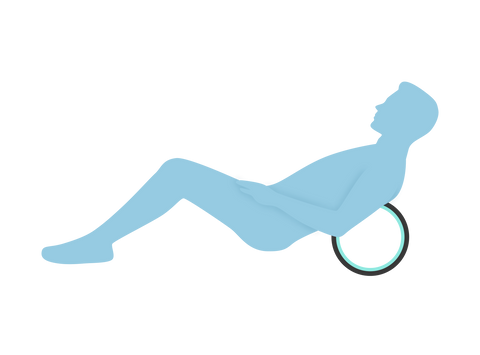Golfing might be the thing you love most. But unfortunately that doesn’t stop you from getting sore muscles, back pain, or even golfer’s elbow on occasion. To help you be able to continue doing more of what you love (golf), we put together a list of stretches for golfers you can do just before you hit the green so that pain doesn’t stop you from getting out there. You can even do these stretches with your golf club and start improving your golf swing today.
Stretches while you’re at the golf course
Standing Spinal twist
This is a great stretch for releasing tension in your hamstrings and lower back and loosening up the muscles around your spine to prepare for your swing.


- Stand with your feet wider than shoulder width apart.
- Place your left hand facing outwards at your lower back. Bend your left leg slightly as you reach your right hand to touch your toes.
- From there, reach up to your left.
- Repeat on both sides.
Toe touches
This stretch helps to relieve tension and stress in your lower back and your legs.

- Stand with your feet shoulder width apart.
- With a slight bend in your knees, reach down to touch your toes.
Mobility twist
This helps increase flexibility in your spine. You might feel a little funny while doing it, but embrace the moment and you’ll feel rejuvenated in the end.

- Stand with your feet a little wider than shoulder width apart. Keep a slight bend in your knees.
- Relax your arms at your sides (keep your arms relaxed throughout the movement).
- Leading from your core muscles slowly twist from side to side so your arms fling around you like long hair would fling. Do this for 30 seconds to a minute.
- Gradually increase your speed and then slowly stop the movement and breathe deeply.
Standing side stretch
This stretch opens up your chest and releases tension throughout your body resulting in reduced lower back pain.

- Hold your golf club in your left hand and step in front of your left leg so your right foot is on the left side of your left foot.
- Holding onto the golf club for support with your left hand, reach your right hand up and over your body. Bring your gaze up to the sky.
- Do this on both sides.
Standing knee to chest
This helps to relax your hips, thighs, and glutes, which are all muscles connected to the lower back. Releasing tension in your legs and hips helps to relieve lower back pain.

- Stand with your feet shoulder width apart.
- Slowly lift your left leg off the ground. Grab your left knee and pull it close to your chest.
- Do this on both sides.
Shoulder flossing
Shoulder flossing helps to increase mobility in your shoulders, which helps prepare you for a bigger golf swing.


- Hold your golf club in both hands at the front of your body.
- Lift your arms up.
- Stretch your arms backwards as far as you can.
- Repeat a few times.
Roll out on the Chirp Wheel+ before you golf
Simply rolling out on the Chirp Wheel before golfing will help increase your back’s flexibility.
How to use the Chirp Wheel+:
Sit and lean back.

- Sit on the ground with knees bent and feet firmly planted.
- Place the Chirp Wheel+ against your back in alignment with your spine. Take some time to center yourself and find balance even on the ground.
- Lean back gently to transfer your weight to the wheel. Relax and find balance in this position before lifting your hips.
Lift hips.

- Rest your hands on the ground, the wheel, or your chest for balance. Do whichever feels the most comfortable for you.
- Lift your hips upward while relaxing your back. Find balance with your hips lifted before rolling on the wheel.
- Don’t tense up! The more you relax your back, the better it will feel.
Roll back and forth.

- Begin to roll back and forth on the wheel by bending and straightening your legs. Use your hands for balance. If one spot on your back needs an extra massage, stop rolling to put pressure on that spot. Or switch to a smaller wheel.
- Roll out for 3 to 5 minutes. Length of preferred use will vary by individual.
- Relax your head back to avoid neck pain.
What to do about Golfer’s Elbow
Golfer’s elbow, similar to tennis elbow, happens when you repeatedly use your wrists or clench your fingers, causing pain where the tendons of your forearms attach to your elbow. You might feel pain in your forearm and wrist.
How to prevent Golfer’s Elbow
- Strengthen your forearm muscles. Wrist curls, pullups, farmer’s walk and other forearms exercises can help you strengthen your forearm muscles and prevent Golfer’s Elbow.
- Do the stretches provided above before you golf. Stretching does wonders for your body. Warming up your muscles before you golf can benefit your game.
- Check with an instructor about proper form. Make sure you haven’t fallen into any bad habits when it comes to your golfing form. Check periodically with an instructor to make sure you are golfing properly.
- Check your equipment. Heavy golf irons can increase your chances of golfer’s elbow. If it’s in your budget, upgrade to lighter graphite clubs.
- Lift correctly. When you lift anything at all, pay extra care to your wrist. Keeping your wrists rigid, straight, and stable will reduce the force to your elbow.
- Take a break. Listen to your body and rest when you need to. Overplaying can cause injury and even prevent you from playing as much as you’d like to. Take breaks so that you can have freedom to play.
References
Bleier, R. (2020, August 26). These 5 simple stretches will improve your flexibility and help your golf swing. Retrieved from https://golf.com/instruction/fitness/stretching-routine-improve-flexibility-golf-swing/
Cronkleton, E. (2021, June 10). 7 lower back stretches to reduce pain and build strength. Retrieved from https://www.healthline.com/health/lower-back-stretches#childs-pose
Cronkleton, E. (2019, June 24). 12 forearm exercises to do at the gym or at home. Retrieved from https://www.healthline.com/health/forearm-exercises#without-weights
Mayo Clinic. (2021). Golfer’s elbow. Retrieved from https://www.mayoclinic.org/diseases-conditions/golfers-elbow/symptoms-causes/syc-20372868








